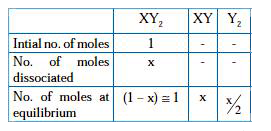The equilibrium for the dissociation of XY2 is given is,
2XY2(g)↔2XY(g)+Y2(g)
If the degree of dissociation x is so small compared to one. Show that 2KP=PX3 where P is the total pressure and KP is the dissociation equilibrium constant of XY2.
2XY2(g)↔2XY(g)+Y2(g)

Total no. of moles =1−x+x+x2⇒1+x2≅1
[∴ Given that x<<1:1−x≅1 and 1+x2≅1]
KP=(PXY)2(PY2)(PXY2)2=(x1×P)2(x/21×P)(11×P)2
K_(P)= (x^(2) cancel(P^2)xx P)/(2 cancel(P^2))
⇒2KP=x3P.
Topper's Solved these Questions
- PHYSICAL AND CHEMICAL EQUILIBRIUMBOOK - NCERT TAMILCHAPTER - PHYSICAL AND CHEMICAL EQUILIBRIUMEXERCISE - EVALUATION (MCQs)
25 Videos
- PERIODIC CLASSIFICATION-IBOOK - NCERT TAMILCHAPTER - PERIODIC CLASSIFICATION-IEXERCISE - Questions (Explain briefly the following)
19 Videos
- PURIFICATION OF ORGANIC COMPOUNDSBOOK - NCERT TAMILCHAPTER - PURIFICATION OF ORGANIC COMPOUNDSEXERCISE - QUESTION
30 Videos
Similar Questions
The dissociation equilibrium of a gas AB2 can be represented as, 2AB2(g)⇔2AB(g)+B2(g). The degree of disssociation is 'x' and is small compared to 1. The expression relating the degree of dissociation (x) with equilibrium constant kp and total pressure P is
View SolutionFor the dissociation reaction N2O4(g)⇔2NO2(g), the degree of dissociation (α)interms of Kp and total equilibrium pressure P is:
View Solution
Knowledge Check
The dissociation equilibrium of a gas AB2 can be represented as, 2AB2(g)⇔2AB(g)+B2(g). The degree of disssociation is 'x' and is small compared to 1. The expression relating the degree of dissociation (x) with equilibrium constant kp and total pressure P is
A(2Kp/P)B(2Kp/P)1/3C(2Kp/P)1/2D(Kp/P)The dissociation of a gas AB2 at equilibrium can be represented as :
2AB2(g)⇔2AB(g)+B2(g)
The degree of dissociation is x and is small compared to I. The expression relating the degree of dissociation (x) with equilibrium constant Kp and total pressure P is :A(2K1/P)B(2Kp/P)1/3C(2Kp/P)1/2D(Kp/P)For the dissociation reaction N2O$(g)⇔2NO2(g), the degree of dissociation (α)interms of Kp and total equilibrium pressure P is:
Aα=√4P+KpKPBα=√KP4P+KpCα=√KP4PDnone of these
The dissociation equilibrium of a gas AB2 can be represented as, 2AB2(g)⇔2AB(g)+B2(g). The degree of disssociation is 'x' and is small compared to 1. The expression relating the degree of dissociation (x) with equilibrium constant kp and total pressure P is
View SolutionThe dissociation equilibrium of a gas AB2 can be represented as, 2AB2(g)⇔2AB(g)+B2(g). The degree of dissociation is x and is small compared to 1. The expression relating the degree of dissociation (x) with equilibrium constant kp and total pressure P is :
View SolutionThe dissociation equilibrium of a gas AB2 can be represented as, 2AB2(g)⇔2AB(g)+B2(g). The degree of disssociation is 'x' and is small compared to 1. The expression relating the degree of dissociation (x) with equilibrium constant kp and total pressure P is
View SolutionThe dissociation equilibrium of a gas AB2 can be represented as :
2AB2⇔2AB(g)+B2(g)
The degree of dissocaition x is very small as compared to 1. The expression which relates the degree of dissociation (x) with equilibrium constant (Kp) and total pressure (p) is :
View SolutionAt a certain temperature T, a compound AB4(g) dissociates as 2AB4(g)⇔A2(g)+4B2(g) with a degree of dissociation x, which is very small as compared to unity. The expression of Kp interms of x and total equilibrium pressure p is-
View Solution
